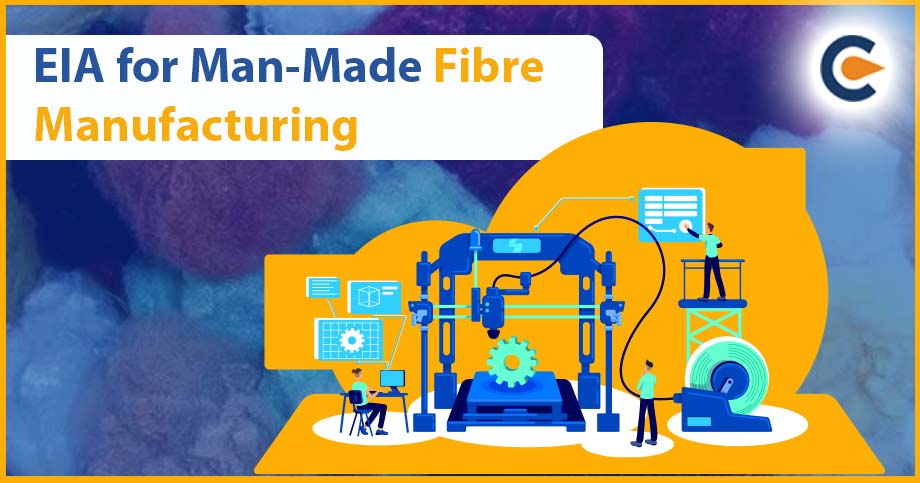There are two types of fibres – natural and man-made. Natural fibres are based on their origin, which plants, animals, and geological processes produce. They are biodegradable over time and consist of polymers. Examples of some of the natural fibres are vegetable fibres (cotton, jute, flax, ramie, etc.), plant fibres (plant and textile), wood fibre, animal fibres (spider silk, wool, catgut, sinew, etc.) and mineral fibres (asbestos). EIA (Environmental Impact Assessment) is a process that evaluates the potential environmental impact of a proposed project before it is approved or implemented. In the context of EIA for Man-made fibre manufacturing, the EIA would consider the potential environmental impacts of the manufacturing process from raw materials used to create the fibres, the manufacturing process, and disposal of any waste products generated. The EIA would also consider the potential impact of the manufacturing process on air and water quality, noise pollution, and wildlife and natural habitats. The results of the EIA would inform decision-makers and stakeholders about potential environmental impacts and identify mitigation measures to reduce or prevent negative impacts.
Laws and Regulations Concerning EIA for Man-Made Fibre Manufacturing
In India, MoEFCC regulates the EIA process for man-made fibre manufacturing and other industrial activities.
- The EIA process is governed by the Environmental Impact Assessment Notification, 2006[1]. Under the current regulations, any proposed man-made fibre manufacturing project that meets specific threshold criteria must undergo an EIA. The threshold criteria include the project’s size, the process’s nature, and the project’s location.
- The EIA process involves a detailed assessment of the potential environmental impact of the proposed project, including its impact on air and water quality, noise pollution, and wildlife and natural habitats. The EIA report must also include a detailed mitigation plan to address any potential negative impacts identified during the assessment.
- Once the EIA report is prepared, it must be submitted to the MoEFCC for review and approval. The MoEFCC may require additional information or modifications to the project plan before approval.
- In addition to the EIA process, man-made fibre manufacturing projects are subject to other environmental regulations and requirements, such as air and water pollution control standards and waste management regulations. Failure to comply with these regulations can result in fines and penalties and may even result in the shutdown of the manufacturing facility.
Process of Obtaining EIA for Man-Made Fibre Manufacturing
Obtaining an Environmental Impact Assessment (EIA) for Man-made fibre typically involves several steps. Here is a general overview of the process:
- Scoping: The first stage in the EIA process is scoping, which involves identifying the proposed project’s potential environmental impacts and determining the EIA study’s scope.
- Preparation of The EIA Report: The next step involves preparing the EIA report. This report includes a detailed assessment of the proposed project’s potential environmental impacts and a mitigation plan to address any negative impacts.
- Submission of The EIA Report: Once the EIA report is prepared, it must be submitted to the appropriate regulatory authority, such as the Ministry of Environment, Forest and Climate Change (MoEFCC) in India.
- Review and Approval: The regulatory authority reviews the EIA report and may require additional information or modifications to the project plan before approval.
- Public Consultation: In many cases, public consultation is required as part of the EIA process. This may involve holding public hearings or soliciting public feedback on the proposed project.
- Monitoring and Compliance: Once the project is approved, the regulatory authority will monitor it to ensure it complies with the conditions given in the EIA report. This may involve regular reporting and monitoring requirements.
Note – It is important to note that the specific process for obtaining an EIA for Man-made fibre may vary depending on the location and regulatory requirements.
Documents Required To Obtain EIA for Man-Made Fibre Manufacturing
In India, the documents required for obtaining an Environmental Impact Assessment (EIA) for Man-made fibre are governed by the Environmental Impact Assessment Notification, 2006, amended in 2020. Some common documents that may be required for obtaining an EIA for Man-made fibre in India include:
- Form 1: This is the initial application form for seeking environmental clearance for the proposed project.
- Environmental Management Plan (EMP): This plan outlines the steps that will be taken to mitigate any potential negative impacts on the environment.
- Site Plan and Layout: This document provides a detailed project site plan, including the location of critical infrastructure and facilities.
- Baseline Data Report: This report provides data on the existing environmental conditions at the project site, such as air and water quality, noise levels, and biodiversity.
- Impact Assessment Report: This report assesses the potential environmental impacts of the proposed project, including its impact on air and water quality, noise pollution, and wildlife and natural habitats.
- Risk Assessment Report: This report assesses the potential risks associated with the project, including any potential health and safety risks to workers or nearby communities.
- Environmental Monitoring and Management Plan: This plan outlines the steps that will be taken to monitor and manage any potential environmental impacts during the operation of the project.
Note – It is important to note that the specific documents required for obtaining an EIA for Man-made fibre in India may vary depending on the size and nature of the project. It is advisable to consult with an environmental consultant to determine the specific requirements for the project.
Conclusion
EIA for Man-made fibre manufacturing helps to identify and assess the potential environmental impacts of the proposed project, promote transparency and public participation, and ensure compliance with regulations. The EIA process in the case of man-made fibre provides a mitigation plan to reduce or eliminate any adverse environmental impacts. It helps to inform project planning and decision-making to ensure environmental sustainability and responsibility. The EIA process in India is governed by the Environmental Impact Assessment Notification, 2006, which outlines the documents and procedures required for obtaining environmental clearance. Man-made fibre manufacturing companies must comply with EIA regulations to minimize adverse environmental impacts and ensure sustainable development.
Also Read:
Types Of Environmental Impact Assessment
Moef&CC Guidelines On EIA For River Valley Projects
Environmental Clearance Process In India: A Complete Outlook











